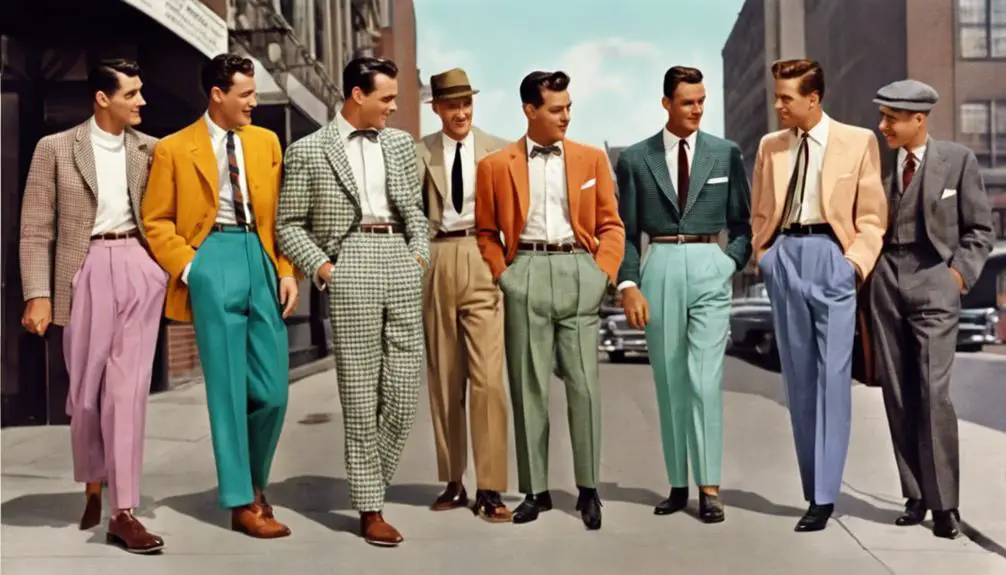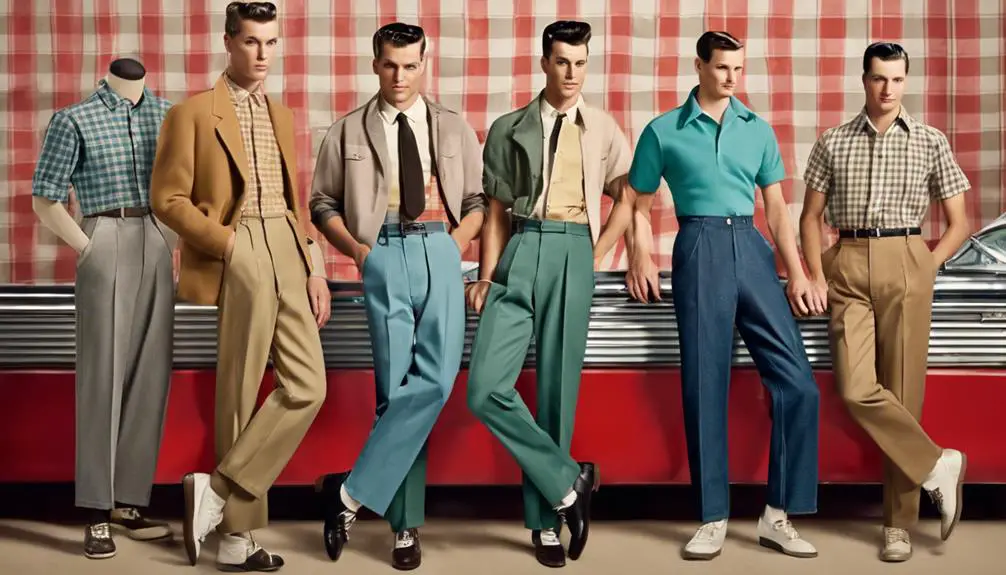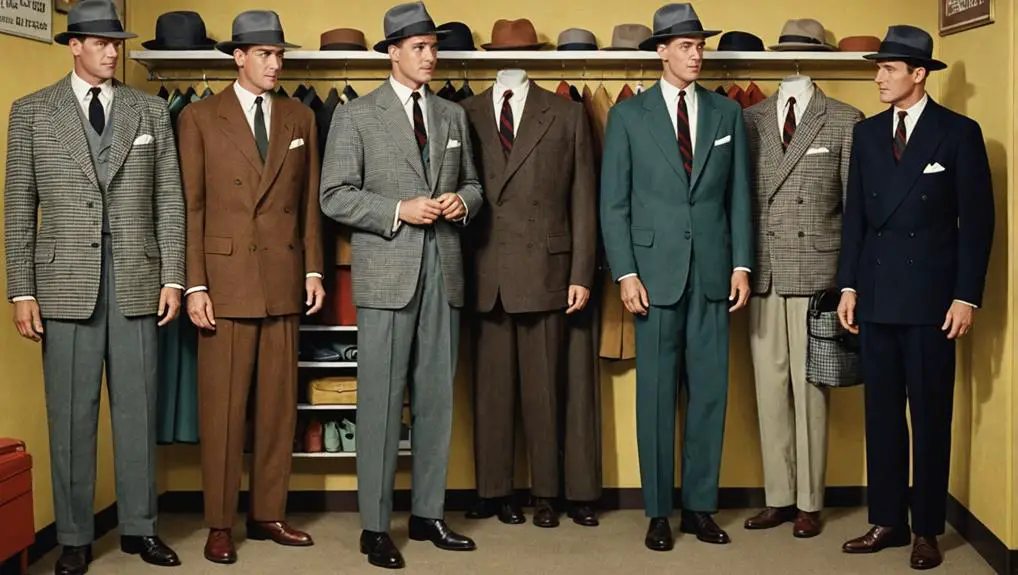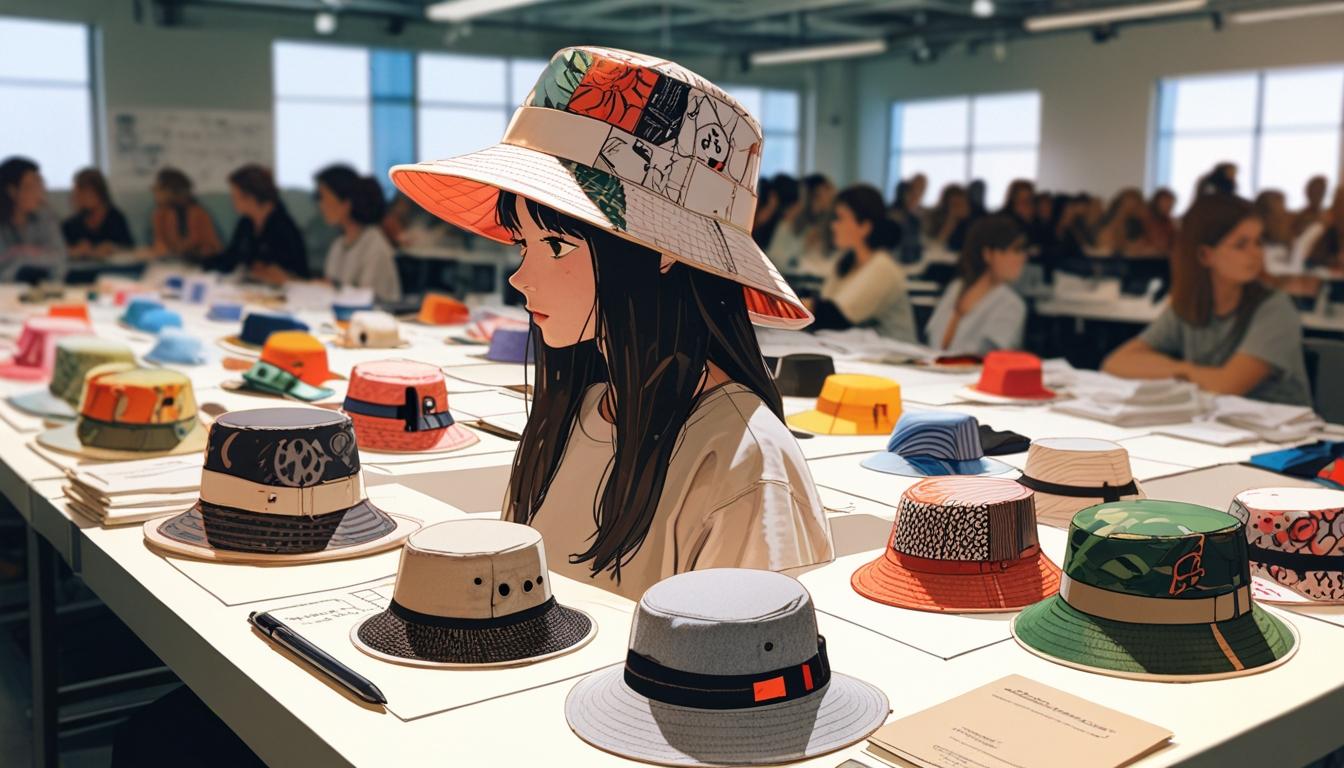In the 1950s, men's trousers showcased a unique blend of styles and materials. You'd find high-waisted, wide-leg designs, often embellished with sharp pleats and colorful patterns. Fabrics ranged from wool blends for warmth to lighter cotton and rayon for comfort. Typical colors included classic neutrals like chocolate brown and vibrant shades like teal. Flat front trousers began to rise, reflecting a shift towards a slimmer fit. Brands like Haggar and Key Industries catered to both formal and casual needs. This evolution mirrors broader societal changes of the time, hinting at the diverse influences shaping men's fashion culture. You might be intrigued by the details of this transformation.
Styles of 1950s Mens Pants

In the domain of men's fashion, the trousers of the 1950s stand out for their unique blend of style and structure. You'll notice that pleated designs were prevalent, creating a polished look with a sharp center crease that emphasized sophistication. The high waist, reaching up to the belly button, offered a formal silhouette, which was a hallmark of the decade. This era also saw the emergence of specific vintage clothing labels that defined the trends of the time, contributing to the overall aesthetic of menswear.
Wide leg trousers became the go-to choice for many, especially in denim jeans, often paired with rolled cuffs to strike a casual yet stylish tone. You could choose from a variety of colors, with mens vintage options showcasing vibrant shades like teal and maroon alongside traditional tones like medium blue and chocolate brown.
As the decade progressed, a shift occurred towards narrower fits, marking the introduction of flat front trousers. These trousers catered to a more modern aesthetic, diverging from the structured wool trousers and suit pants that defined earlier styles. This evolution in trouser design reflects the changing attitudes toward fashion and comfort in the 1950s, offering a glimpse into how men's pants transformed from the formal to the more relaxed.
Fabrics Used in 1950s Mens Pants
The evolution of men's trousers in the 1950s was not just about styles but also greatly influenced by the fabrics used. This decade balanced tradition and innovation, with wool blends prevailing for both winter and summer trousers. These fabrics provided the warmth and versatility needed for various occasions, especially for dress pants.
Alongside wool, lighter synthetic materials like rayon began to emerge, leading to the popular rayon blend pleated options. This shift reflected a growing desire for comfort, allowing you to enjoy a more relaxed fit. Cotton blends, favored for their breathability, became staples in casual wear, particularly in straight leg designs that complemented everyday activities.
Textured fabrics gained prominence, enhancing the visual appeal of men's trousers. You might have noticed options featuring speckled and splash wave patterns, which added character to your wardrobe. For fall and winter, corduroy emerged as a favored choice, offering both warmth and a rich, textured look. The pleated front designs also contributed to the overall sophistication of trousers, merging style and function seamlessly. Altogether, the fabrics of the 1950s shaped a distinctive menswear aesthetic that balanced warmth, comfort, and visual interest.
Popular Colors and Patterns

While trends shifted throughout the 1950s, the colors and patterns of men's trousers played an essential role in defining the decade's fashion. You'd often see trousers in medium blue, chocolate brown, grey, and tan, offering a versatile palette. Casual options even embraced vibrant hues like pink and teal, which contrasted the more subdued tones of formal wear.
The patterns were equally engaging. Vertical stripes and plaid dominated the scene, providing a visual punch that complemented the narrower fits emerging by the late 1950s. Textured fabrics, featuring designs like speckled and splash wave patterns, brought an additional layer of interest, elevating the overall aesthetic of trousers.
Here's a quick overview of some popular colors and patterns:
| Color | Pattern |
|---|---|
| Medium Blue | Vertical Stripes |
| Chocolate Brown | Plaid |
| Grey | Small Checks |
| Tan | Tweed |
This combination of classic neutrals and bold patterns not only captured the spirit of the decade but also set the stage for evolving men's fashion in the years to come.
Notable Brands and Products
During the 1950s, notable brands introduced innovative products that shaped men's trouser fashion considerably. One standout was the Haggar Mynx Gabardine dress pants, featuring a hidden expandable waist that provided unparalleled comfort and flexibility for the wearer. This design not only catered to the need for style but also emphasized practicality, making it a popular choice among men seeking fashionable yet functional trousers.
Revival brands played an essential role by offering authentic vintage-inspired trousers reminiscent of the 1940s and 1950s. These 1950s pants appealed to collectors and fashion enthusiasts seeking a touch of nostalgia. Among the iconic styles was the Rockabilly Pistol Pants, known for their vibrant colors, including turquoise, which captured the playful aesthetic of the era.
Key Industries contributed to the workwear segment with their durable denim dungaree pants, celebrated for their practicality. Additionally, the rise of Wool Flat Front and pleated pants offered men a sophisticated option for both formal and casual settings. This diverse array of trousers showcased the evolving tastes of the decade while allowing modern consumers to appreciate classic styles without sacrificing contemporary fashion sensibilities.
Evolution of 1950s Mens Pants

In the 1950s, men's trousers underwent a remarkable transformation that reflected broader societal changes and evolving fashion sensibilities. You'd notice a significant shift from high-waisted, wide-legged trousers to slimmer fits as the decade progressed. This evolution was marked by several key trends:
- Flat front trousers became a popular summer choice, offering a modern silhouette.
- Pressed leg seams gained traction, emphasizing a neat, tailored appearance.
- Casual slacks emerged, catering to the everyday needs of men, with relaxed fits for comfort.
Frequently Asked Questions
What Trousers Did Men Wear in the 1950s?
In the 1950s, you'd see men favoring high-waisted trousers with pleats and wide legs. Fabrics varied from wool blends to lighter synthetics, with colors like medium blue and chocolate brown dominating the styles of the era.
What Were Pants Called in the 50s?
In the 50s, pants were often called slacks, dress pants, or trousers. The term chinos emerged for casual styles, while denim jeans, or dungarees, became essential for relaxed wear, reflecting evolving fashion preferences and cultural influences.
What Did Men in the 1950S Wear?
In the 1950s, you'd find men wearing high-waisted trousers, often pleated, alongside casual denim jeans. Fabrics varied from wool to rayon, and vibrant colors and patterns reflected a playful, evolving approach to fashion during that era.
When Did Men Start Wearing Trousers?
You'll find that men started wearing trousers as early as the 16th century. Over time, trousers evolved into essential attire, becoming standardized by the 19th century and replacing knee breeches as the primary lower-body garment.





Thanks , I’ve just been looking for information approximately this topic for a while and yours is the greatest I’ve found out so far. But, what about the conclusion? Are you certain about the supply?
I am curious to find out what blog system you have been using? I’m experiencing some minor security issues with my latest website and I would like to find something more secure. Do you have any recommendations?
You’re so interesting! I don’t suppose I have read something like this before. So nice to discover another person with a few genuine thoughts on this subject. Seriously.. many thanks for starting this up. This web site is something that’s needed on the web, someone with a little originality!
It’s not my first time to visit this web site, i am browsing this website dailly and get good facts from here all the time.
We stumbled over here coming from a different web page and thought I might check things out. I like what I see so now i’m following you.Look forward to finding out about your web page yet again.
My partner and I stumbled over here coming from a different page and thought I might check things out. I like what I see so i am just following you. Look forward to finding out about your web page yet again.